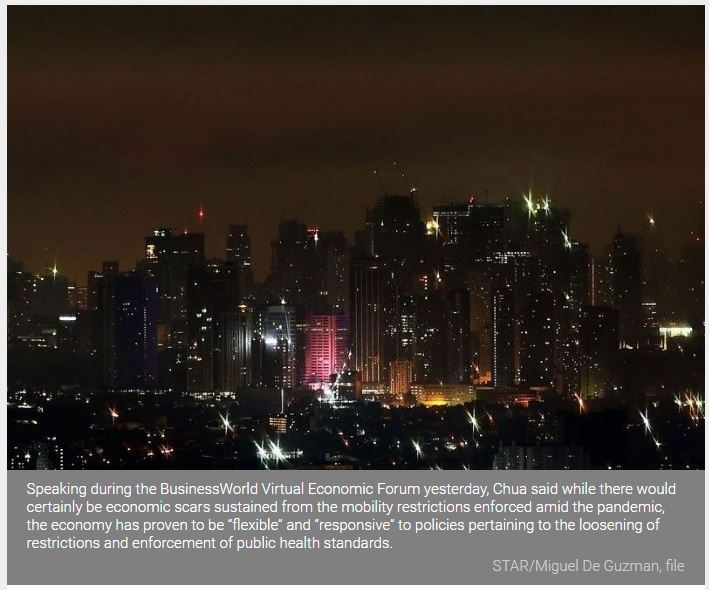Philippines: Growth to resume only by 2022
MANILA, Philippines — Growth will likely return to its pre-pandemic trajectory by the middle of 2022 when the economy has fully adapted to interventions and precautions implemented in line with its reopening, according to acting Socioeconomic Planning Secretary Karl Chua.
Speaking during the BusinessWorld Virtual Economic Forum yesterday, Chua said while there would certainly be economic scars sustained from the mobility restrictions enforced amid the pandemic, the economy has proven to be “flexible” and “responsive” to policies pertaining to the loosening of restrictions and enforcement of public health standards.
He pointed out that prior to the pandemic, the country was on a solid growth trajectory, averaging six percent from 2016 to 2019, and was on track to graduating to an upper middle income economy by World Bank standards.
This level of growth was seen amid the simmering trade war between the US and China, two of the country’s top trading partners.
Poverty reduction targets were also achieved two years ahead of schedule with record lows in unemployment and underemployment.
“So all of these were all good starting points. Yes, there will be scars, there will be delays, but putting all the numbers together, we are seeing a return to 2019 levels sometime in the middle of 2022,” said Chua.
“These are not very far from our present period but we can accelerate that if we focus on the recovery program.”
Nine months into the pandemic, the economy has so far seen three quarters of contraction, the steepest of which being the record 16.9 percent contraction in the second quarter, followed by a less severe decline of 11.5 percent in the third quarter when lockdowns were eased.
The Philippines is still under the world’s longest continuing lockdown although most of the country now remains under the less severe quarantine tiers of general community quarantine (GCQ) and modified GCQ.
The government has since then committed to ensure the continued but gradual reopening of the economy to enable recovery from the pandemic-induced slump.
Chua noted that the government is now changing the pandemic response from total risk avoidance to risk management, taking into consideration that majority of the COVID-19 cases in the country have mild symptoms or are symptomatic, and the death rate is low.
This means ensuring hospitals are well-equipped and deaths are limited to a manageable level by protecting the most vulnerable sectors.
“The economy is very flexible and will respond to the policy we put. It is strong enough to recover if we enable it to do so,” he said.
“The key is to manage risk, not avoid it.”
Under this approach, the escalation of community quarantine level should also only be used as a last resort. If the number of positive cases are rising, the current quarantine tier may be retained but health protocols must be tightened and localized quarantines be imposed instead of locking down whole regions.
In the same forum, Dr. Edsel Salvaña, director of the Institute of Molecular Biology and Biotechnology of the University of the Philippines Manila, said the curve of infection appears to be finally flattening, but warned this is still not the time to be lax with the enforcement of public health standards.
“The curve seems to be flattening. The r-naught is less than one and deaths are relatively low. But we still need to keep the minimum health protocols,” he said.
Following the downward revision in the second quarter performance and the still steep decline in the third quarter, the Development Budget Coordination Committee (DBCC) will have to recast its macroeconomic assumptions and fiscal program.
The third quarter contraction brought the year-to-date average contraction to 10 percent, making it impossible to meet the negative 5.5 percent full-year economic performance forecast of the government.
Chua said the executive technical board advising the DBCC is still meeting while the DBCC itself will convene “toward the end of the week or early next week.”
“But what we are looking here is the fact that the reopening of the economy appears to be the most important policy so long as we do it as safely as possible,” said Chua.
World Economic Forum president Børge Brende said despite the present challenges experienced by the Philippines in relation to the pandemic, the country remains in a good position for recovery if appropriate policies are put in place.
The country, for instance, still enjoys a tech-savvy, young population that can participate in the digital transformation of the economy if the right jobs are created.
The country also has good economic relations with powerful economies in Asia such as China, Japan and South Korea; and maintains strong economic ties with the United States.
“This year marks the entry into the Asian Century. This is the first time that Asia makes up 50 percent of the global GDP and global population,” said Brende.
The biggest challenge in the country remains to be the attainment of sustainability and inclusivity of growth especially for the millions of young workers whose employment prospects were put on hold by the crisis.
“In the Philippines, there is a lot of young people so there is a million of new jobs that have to be created in the years to come. So you need to have a robust business sector,” said Brende.
Source: https://www.philstar.com/business/2020/11/26/2059429/growth-resume-only-2022


 Thailand
Thailand




